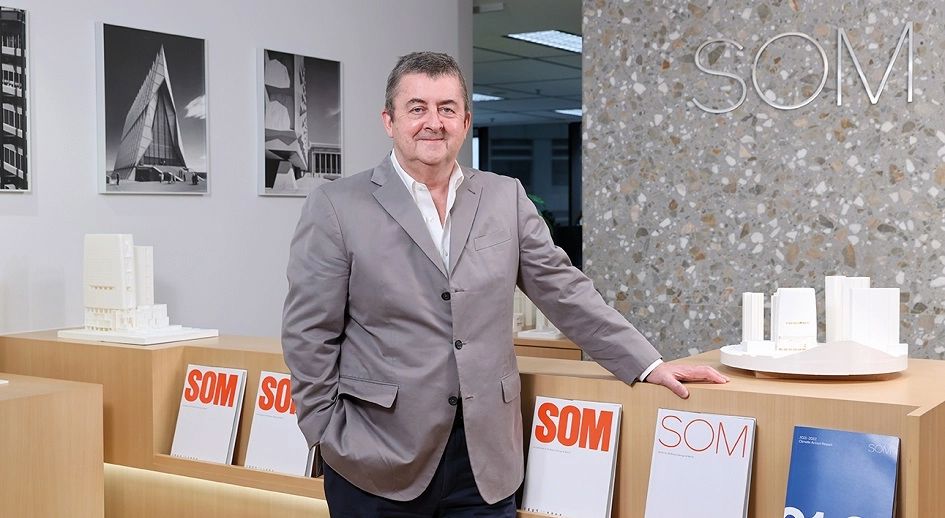From Hong Kong to GBA — Building from Strength to Strength
Global architectural practice Skidmore, Owings & Merrill (SOM) has been active in Hong Kong for half a century. Now, thanks to the Guangdong-Hong Kong-Macao Greater Bay Area (GBA), it is also working across the border to transform the architectural landscape while introducing new concepts in sustainability and innovation.
Thriving Business Environment for Growth
Architecture firm Skidmore, Owings & Merrill (SOM) has had a presence in Hong Kong since 1974 and is coming up to its 50th anniversary here this year. SOM has been drawing synergistically on Hong Kong’s many advantages as a place to do business while at the same time contributing enormously to the city’s architectural development. Having its Hong Kong office as the centre for SOM’s wider Asia practice brings the company all sorts of benefits. SOM’s Asia Practice Leader Peter Brannan is effusive in his assessment of Hong Kong’s attraction as a regional centre – “It’s one of the best cities to live in Asia.” This fact has major implications for a company like SOM that relies on having the best international talent at its disposal. “People want to come to Hong Kong,” says Brannan, “and not just for its attractive living conditions. Dynamic and creative people also enjoy rich personal and professional networks, an exceptional work ethic, and the feeling that it’s easy to get things done and get them done quickly.”
Being in Hong Kong also comes with a cachet associated with having the city as a business base, according to Brannan. “Stating that your regional head office is in Hong Kong makes a significant impact,” he notes. The city’s status draws major government and corporate delegations from the GBA, but also from other regions in Mainland China and across the area. For example, local government leaders in the GBA commonly turn to Hong Kong for talent and expertise in new projects. “The opportunities this presents are substantial,” says Brannan, “and we are projecting a further increase in our Asia-Pacific business over the next few years.”
Hong Kong is also the perfect location for projects in China. “SOM has done hundreds of projects across China in recent years, and the GBA is naturally an area of huge potential and ambition,” says Brannan. “We are ramping up our work there and have recently opened an office in Guangzhou to streamline this further.” He is especially enthusiastic about opportunities for collaboration in innovation, both here and in the GBA. “Our ‘Urban Sequoia’ concept demands new approaches, new systems, and new materials in architecture and building,” he notes. “With Hong Kong’s innovative talents and the manufacturing prowess of the GBA on our doorstep, we are in a great position to showcase world-leading architectural sustainability models right here in this city.”
How SOM is making a difference
SOM is renowned for its super-tall buildings around the world; in fact, it is responsible for the world’s tallest building, the Burj Khalifa in Dubai, among numerous other global megastructures. So, it is not surprising that SOM enjoys a major presence in Hong Kong, a city renowned for its soaring skylines. But, says Brannan, SOM is more than a ‘tall building specialist’ and is responsible for some of the world’s most technically and environmentally advanced buildings and significant public spaces. He points to local projects such as the iconic Hong Kong Convention & Exhibition Centre (HKCEC) and the SkyCity Master Plan for the city’s airport.
According to Brannan, SOM’s influence is best observed not in the height of its buildings but in significantly they are contributing to the sustainability of our cities. “SOM is a pioneer and innovator in sustainable thinking,” he says. “We’re at a critical point in human history, and firms like SOM need to lead the way, not just by reducing carbon emissions from their buildings, but also by creating net-zero buildings. I’m excited that this company is visualising buildings in the future that can reduce carbon emissions by up to 340% over their 100-year life span.”
One of SOM’s recent research projects is its ‘Urban Sequoia’ concept, which involves creating buildings that act like trees and, in a sense, ‘absorb’ carbon through a remarkable blend of design and material innovations. “We’re actually reaching a point where we can create or repurpose buildings so that they behave more like living organisms than conventional concrete, metal, and glass edifices,” says Brannan. “The benefits go far beyond carbon reduction, extending into areas such as improved wellness and richer socialisation opportunities for a buildings’ users.”
Brannan admits that development will require further adaption before fully embracing the ‘Urban Sequoia’ concept. “There will have to be government regulation; there will have to be codes that mandate these sorts of sustainability initiatives,” he says. But regulation will come, he insists, and companies that don’t evolve will be left behind. Profit will inevitably be linked with sustainability in the long run.
Fast Facts
- Founded in 1936, Skidmore, Owings & Merrill (SOM) is one of the oldest and largest architectural firms in the world
- SOM is a global practice of architects, designers, engineers, and planners, responsible for some of the world’s most technically and environmentally advanced buildings and significant public spaces
- SOM established its Hong Kong office in 1974, as a regional hub for its activities in Asia
- SOM is a carbon neutral business, read their full Climate Action Report to learn more
(Please click here to download Acrobat Reader)
